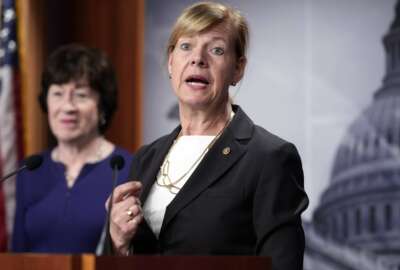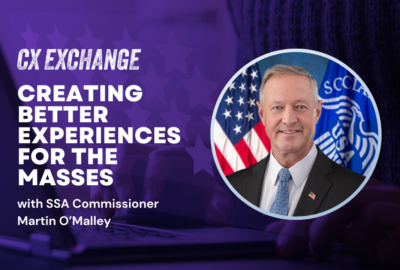Hubbard Radio Washington DC, LLC. All rights reserved. This website is not intended for users located within the European Economic Area.
Despite 50 years of progress, morale gap among LGBT workers persists
Despite a series of efforts to expand the rights of lesbian, gay, bisexual and transgender federal workers by the Obama administration, LGBT feds, who comprise ...
Last week, in a White House ceremony marking LGBT pride month, President Barack Obama announced his administration was working on an executive order to formally extend workplace protections to transgender federal employees.
That was only the latest move in a series of efforts to expand the rights of lesbian, gay, bisexual and transgender federal workers that have marked Obama’s tenure in office.
After the Supreme Court invalidated key provisions of the 1996 Defense of Marriage Act, which had barred the federal government from recognizing any same-sex marriages, the Office of Personnel Management moved swiftly to rewrite regulations to open up more than 1,100 rights and benefits to LGBT employees and their families. Two years earlier, the Obama administration played a key role in ending the ban on openly gay troops in the military.
But despite these gains, an annual survey of federal employees that recently began querying respondents on sexual orientation has revealed a troubling trend.
LGBT federal employees, who comprise 2.7 percent of the federal workforce, are less satisfied, feel less empowered on the job and are less likely to rate their agency’s senior leaders and management as highly as their non-LGBT counterparts, according to the most recent version of the Federal Employee Viewpoint Survey published last fall.
The Merit Systems Protection Board, the agency tasked with safeguarding federal workplace fairness, recently published a report examining the long, fraught history of LGBT discrimination in the federal workplace, as well as current perceptions of such discrimination.
Its key takeaway?
“I think the environment is certainly changing,” Doug Nierle, the report’s project manager, told Federal News Radio in a recent interview. “I think it’s changing for the better. How that results in attitudes about the workplace … I think is going to take a little more time.”
(Story continues below chart)
What’s behind the morale slump?
Overall, federal employees’ satisfaction has been sagging in recent years — a victim of the fiscal pressures squeezing agency budgets.
But according to the most recent findings of the 2013 Federal Employee Viewpoint Survey, overall workplace satisfaction for LGBT employees is a full 6 percentage points lower than for their heterosexual counterparts — 61 percent compared to 67 percent. Just 39 percent of LGBT federal employees said they have a feeling of personal empowerment on the job, compared to nearly half of straight employees.
Meanwhile, less than half of LGBT federal employees — 48 percent — said they had a high level of respect for their agency’s senior leaders, compared to 54 percent of heterosexual employees.
Answers to what’s leading LGBT employees to feel less empowered, satisfied and engaged on the job — especially given all the progress made in recent years — are fleeting.
“I think for any group, whether it’s LGBT employees or any minority groups of any kind, if you don’t view your particular group as having a lot of power in the organization, you may feel that you are less secure,” said Jeff Neal, federal workforce expert and senior vice president at ICF International, who retired as the Homeland Security Department’s chief human capital officer in 2011.
Neal, who first joined the federal government in the late 1970s, was a first-hand witness to the way evolving social attitudes played out in the federal government.
“Years ago, being gay was considered by a lot of people to be a disqualifier for federal employment,” he said. “But, by the time I started working for the government, that was changing.”
‘One homosexual can pollute a government office’
Up until 1975, the federal government specifically sought to bar gay men and lesbians from employment, under the requirement that employees be of “sound moral character,” according to MSPB’s voluminous research.
For those gay employees at the time, the message was loud and clear: Uncle Sam does not want you.
The government’s campaign to rid the civil service of “moral perverts” coincided with broader efforts to root out suspected Communists in the government during the Cold War.
“Perverts will frequently attempt to entice normal individuals to engage in perverted practices. … One homosexual can pollute a government office,” a Senate committee report concluded at the time.
Gay and lesbian employees were routinely rounded up and hounded out of federal service, often with tragic results.
An investigator hired by the State Department and tasked with aggressively rooting out gay employees from the agency’s ranks said his one regret was “when within minutes, and sometimes maybe a week, they would commit suicide,” the investigator is quoted in The Lavender Scare: The Cold War Persecution of Gays and Lesbians in the Federal Government by historian David K. Johnson. “One guy, he barely left my office and he must’ve had this thing in his pocket — and boom! — right on the corner of Twenty-First and Virginia.”
The tide began to turn with a series of court decisions in the 1960s. Finally, in 1975, the Civil Service Commission, the progenitor of the Office of Personnel Management, announced it would only take sexual behavior into account — for both gay and straight employees — if it could be shown to affect job performance.
It would take another two decades before President Bill Clinton would affirmatively declare, by executive order, that agencies couldn’t discriminate against gay and lesbian employees.
Discrimination on the wane?
Such overt discrimination in the federal government appears to have waned.
In a 2010 study by the Merit Systems Protection Board — the most recent data available — only about 1 percent of federal employees reported being the direct targets of sexual-orientation discrimination. Another 3 percent of respondents said such discrimination took place, although they weren’t necessarily the recipient of it.
While that’s about on par with perceptions of discrimination on the basis of national origin and marital status, according to MSPB, it pales in comparison to the workplace discrimination LGBT people face in the broader labor force, which has been estimated at anywhere from 15 percent to 43 percent, according to the Williams Institute, a think tank at UCLA.
The total perception of discrimination based on sexual orientation in the federal workplace — 4 percent — may not sound like much.
“But when you step back and remember the federal civilian workforce is about 1.9 million people, we’re talking about 75,000 to 80,000 people who believe this happens in the workplace,” MSPB’s Doug Nierle told Federal News Radio.
Despite the government’s troubled history, discrimination on the basis of sexual orientation in the federal workplace has never been explicitly prohibited by law.
Congress has repeatedly declined to include sexual orientation in bill after bill passed over the years to otherwise protect federal employees from discrimination. Instead, LGBT federal employees have been afforded a patchwork quilt of legal protections based on interpretations of existing law, unenforceable executive orders and varying levels of agency guidance.
For the longest time, LGBT federal employees were unable to take up workplace grievances with the Equal Employment Opportunity Commission, since that agency’s jurisdiction is set by statute.
But that’s changing, according to EEOC officials.
Agencies turn sharper focus on LGBT discrimination
In 2012, the EEOC affirmed outright that discrimination on the basis of an employee’s gender identity falls under the prohibition on sex discrimination.The year prior, the agency ruled that longstanding safeguards against discrimination based on gender stereotypes could also be used to protect gay and lesbian workers in some circumstances.
Still, whether anti-gay discrimination on its face would run afoul of the law “is something we have not yet said directly in a case,” said EEOC Commissioner Chai Feldblum at an OPM panel discussion last month on “building LGBT equality in the federal workforce.”
Like EEOC, the Office of Special Counsel — which investigates claims of prohibited personnel practices — has also sharpened its focus on LGBT discrimination.
OSC operates under the 1978 Civil Service Reform Act, which bars workplace discrimination based on conduct that doesn’t adversely affect job performance. Since 1980, OPM and, later, OSC have interpreted that to include sexual orientation.
But that longstanding policy has been open to interpretation.
In the middle of the Bush administration, then-head of the OSC, Scott Bloch, sought to abruptly reverse that policy. An inspector general report published last December after a lengthy investigation concluded Bloch, who resigned in 2008, may have been motivated “by a negative personal attitude toward homosexuality.”
OSC “was a different place 10 years ago,” Louis Lopez, OSC’s associate special counsel for investigation and prosecution, told Federal News Radio. He called Bloch’s efforts to roll back LGBT protections “an aberration” in the agency’s history.
Under current Special Counsel Carolyn Lerner, the agency “has been making efforts to make sure that people know about their rights and know that we’re open for business and that they should feel comfortable coming to us,” Lopez said.
‘Once you’re out — you can’t go back in’
Still, events like that and, more broadly, the long distressing history of workplace discrimination against LGBT employees have cast a long shadow.
“People do still have memories of some of the more troubling things that happened in the past,” said John Elias, president of the group, DOJ Pride, which represents about 600 members in the Justice Department.
At DOJ, discrimination isn’t just something relegated to the history books. Less than 10 years ago, Bush administration DOJ official Monica Goodling had a lawyer on contract to the department fired because the employee was rumored to be a lesbian, according to a 2008 inspector general report that cited a pattern of politicized hiring and firing at the agency.
Fear of a return to those types of reprisals could be tamping down morale and keeping employees closeted, Elias said.
“Once you’re out, you’re out — you can’t go back in,” he said.
While almost 3 percent of federal employees self-identified as LGBT in last year’s survey, nearly five times as many respondents — 12.4 percent — declined to say.
While there are many reasons why employees would choose not to share their sexual orientation, MSPB’s research suggested the “greatest determinant” in whether employees divulge that information is their level of workplace satisfaction. That is, employees who are more satisfied with their jobs and their bosses are more likely to be open about their sexual orientation when asked.
The persistence of a morale gap suggests there continues to be some dissatisfaction on the part of LGBT employees.
DOJ Pride has been asking the department for years to conduct a more targeted survey of its workforce “to gauge sentiment among LGBT employees in particular,” Elias said. “We do hear all kinds of stories about where the climate is not as inclusive as it should be, and we would like some documentation of that.”
Still, things are improving, he said.
“It’s certainly been getting better each and every year that I have been working for the federal government,” said Elias, who joined the department in 2006. “I think there’s certainly plenty of room for work to be done, but I think there’s been a lot of positive progress.”
Just one example: For much of the Bush administration, the group was all but declared persona non grata by agency leadership, barred from using work email or hallway bulletin boards to advertise its events. Its membership dwindled to about 100 members
Not only has the group flourished since, it’s back on firmer footing with department leadership. At DOJ’s pride celebration last month, the group presented Attorney General Eric Holder with an award for his leadership on LGBT issues.
For State employees, a foreign problem
At the State Department, LGBT employees — particularly those in the Foreign Service — are also largely satisfied with the level of engagement from agency leadership.
“The problem is not here — it’s in the foreign governments,” said Robyn McCutcheon, president of the group GLIFAA, which advocates on behalf of LGBT employees at State and the U.S. Agency for International Development.
That’s the irony faced by LGBT State Department employees posted overseas: Even as the U.S. government has evolved on LGBT rights and the State Department, in particular, has taken broad steps to be a more inclusive employer, “we find retrenchment in some of the rest of the world that is making it harder for an LGBT family in the Foreign Service to serve successfully overseas,” she said.
Host countries, sometimes hostile to LGBT rights, have the final say about whether a Foreign Service’s spouse and family can also receive accompanying visas — diplomatic niceties typically unquestioned when requested by heterosexual diplomats.
GLIFAA leaders said agency leadership, though, is listening to their concerns.
At last month’s State Department pride celebration, Secretary of State John Kerry said the U.S. would begin to “push back” against unwelcoming countries.
Transgender employees face new frontier
However, LGBT employees can also face some blowback of their own from within the department.
“I’m not going to sit here and tell you that discrimination does not still exist; it does,” McCutcheon said. “You will have individual managers. You will have individual office situations. That does happen.”
In fact, when McCutcheon became the first Foreign Service officer to come out as transgender and transition on the job while serving in Bucharest, Romania, in 2010, the initial reaction among some of the management “was to get me gone,” she said.
But she persevered, eventually winning the backing of the ambassador and colleagues on post. Later, she wrote the department’s first report on transgender issues.
“She didn’t just get through a difficult period; she was determined to turn it into a precedent-setting event, and as a result she made it a lot easier for those — or at least a little easier — for those who follow,” Kerry said at last month’s pride celebration.
McCutcheon, who said raising awareness of transgender employees is still a new frontier, acknowledged transitioning on the job remains difficult. But the department is moving in the right direction, she said.
McCutcheon, who has spent the past year back at State Department headquarters in Washington, D.C., is preparing to head overseas again this fall to Kazakhstan, where she’ll serve for the next three years as the environment, science, technology and health officer covering Central Asia.
It’s not exactly the most LGBT-friendly part of the world, McCutcheon acknowleged.
“But this department has all the confidence in sending me to serve there,” she said.
(This story is the second in a series examining trends in the annual Federal Employee Viewpoint Survey. The previous installment focused on veteran-employee morale.)
RELATED STORIES:
Obama to expand safeguards for transgender workers
Obama to sign order extending LGBT protections
Supreme Court’s DOMA decision grants thousands of feds access to benefits
Copyright © 2024 Federal News Network. All rights reserved. This website is not intended for users located within the European Economic Area.
First Look
IT Modernization
Read more
CX Exchange 2024: SSA’s Martin O’Malley on creating better experiences for the masses
Related Topics




